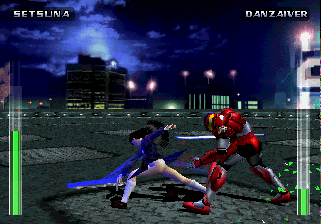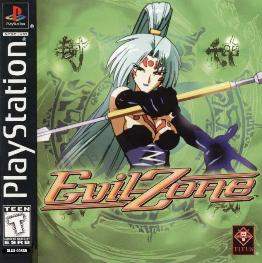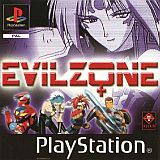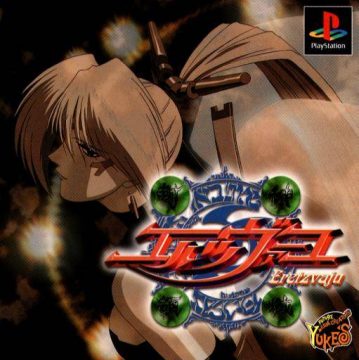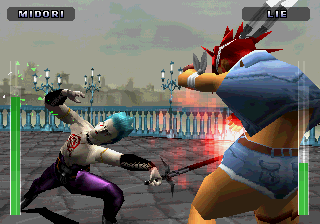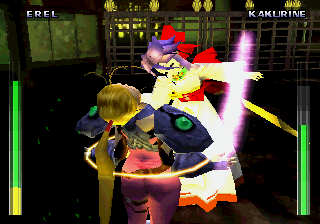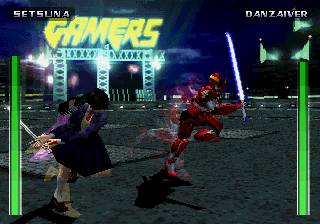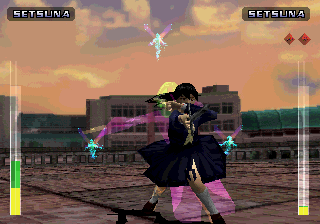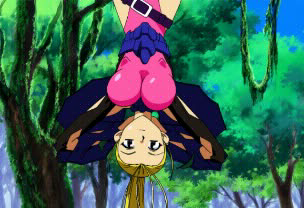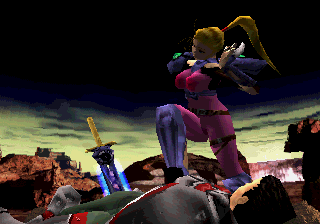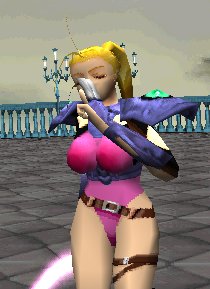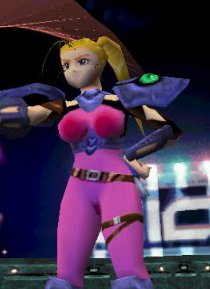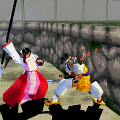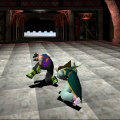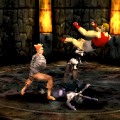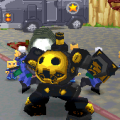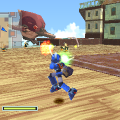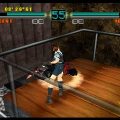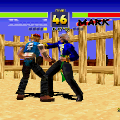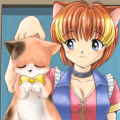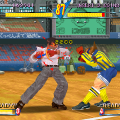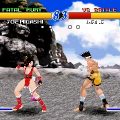In 1999, there was a relatively small developer named Yuke’s. Before they got wrapped up in licensed Naruto fighting games and Rumble Roses sequels, they had an idea, a potentially brilliant idea – what if victory was purely based on quick reflexes, timing and precision, rather than memorizing huge lists of combos and memorizing other obscure knowledge? It would allow people totally intimidated by Virtua Fighter or Tekken, and be able to kick ass without studying tomes of movelists. Due to this unique take, it would also allow for more dramatic battles, a bit more interesting than your dull ordinary horizontal fighting. Unfortunately, this system had one crippling surface flaw: it utilized only one attack button. Welcome to Eretzvaju, also known as Evil Zone.
The story is your usual fighting game fluff and is used entirely as an excuse to have all the various characters face off. An evil being known as Ihadulca threatens the world of I-Praseru (Kumi/Happy Island) and so, at great cost, they manage to seal her in the Evil Zone. However, this apparently will not prove a permanent solution, as Ihadulca is breaking free. So, a group of fighters have been summoned from other dimensions to determine their strengths. The most powerful will be chosen to fight Ihadulca. (Why couldn’t they all just fight her at once?)
Characters
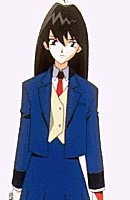
Setsuna Saizuki
The Guardian Angel
Considered to be the main character due to her having an extended ending compared to the other characters. Setsuna falls straight out of a magical girl anime, except she doesn’t really transform. She houses a spirit known as Karin. who has a connection to Ihadulca, and is also childhood friends with Midori. Bears a vague resemblance to Gogo Yubari from Kill Bill, even though this game came out years before the movie.
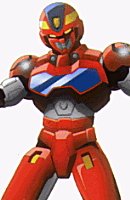
Danzaiver (Sho)
Exceptional Inspector
Danzaiver is a Henshin hero homage who, along with Yuri and Ruri, (twins who operate his orbital satellite the Seingreed and are never seen outside of a cutscene) battle Gillaclva in their home dimension. Yuri is kidnapped and used to seal Ihadulca in the Evil Zone. Now it’s up to the self proclaimed ultimate hero Danzaiver to defeat Ihadulca and save Yuri.

Alty Al Lazel
Wizard
A young but talented magician who summoned all the non-I-Praseruians to I-Praseru. However after doing so, he realized that the people I-Praseru should fight their own battles and so he sets out himself to defeat Ihadulca. Al also hopes to prevent Erel from being hurt.
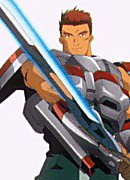
Gally Vanish Gregman
The Bounty Hunter
A bounty hunter from the world of Aradia. There is a bounty on Ihadulca and that’s the whole reason he’s involved. Apparently a nice guy despite being more than happy to hack anyone in his way to pieces with his rather large sword.
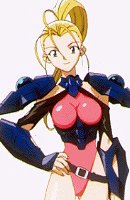
Erel Plowse
Mercenary
Erel seeks to right injustices and to prevent her beloved Al from risking his life by fighting Ihadulca. Her armor is later revealed to have been specifically designed to kill Ihadulca, designed by Kakurine. Her story mode is filled with lots of cutesy scribblings.
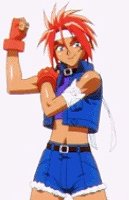
Midori Himeno
Grappler and Passionate
A student and inheritor of an ancient silent assassination dojo, Midori fights with a loud aggressive bare fist fighting technique. Midori is seeking to increase her fighting skill by battling the other characters and ultimately Ihadulca. She is friends with Setsuna, and when she was younger, her life was saved by Keiya, though the two seem to hate each other. Bears a vague resemblance to Kanna from Sakura Taisen.

Keiya Tenpouin
The Man in the Shadow
A Japanese spellcaster using Chinese yin-yang philosophies. By far the most deliciously evil character in the game, relentless and remorseless in killing all those who get in his way. He wants Ihadulca’s power to resurrect his lifelong friend Himika who was drained of her life energies by Lie. He hates Lie and has a history with Midori.

Linedwell Rainrix (Lie)
A Medium at Daybreak
An unemployed heavy metal musician who was compelled to steal a sword from an antique shop. The sword actually contains an incarnation of Satan and compels Lie to kill. Lie seems to be completely unaware of being possessed until late in his storyline. It is also not stated whether Lie was a serial killer before he obtained the sword.
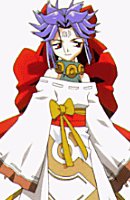
Kakurine
Priestess
Kakurine is a 10,010 year old goddess who existed in a different dimension in a bodyless existence with Ihadulca’s original form Lea. When Lea found a way to incarnate herself in physical forms, therein ditching Kakurine, the little girl was heartbroken. Kakurine then decided that the only way to make Lea love her again was to kill each and every incarnation of Lea so that she would be forced to return to their dimension and love Kakurine again. For a 10010 year old goddess, Kakurine isn’t too bright. She constructed the void armor and helps mortals who seek to kill Lea’s incarnations.
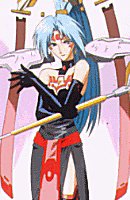
Ihadulca
The Absolute Existence
The main villain, and one of many incarnations of a being known as Lea. Original a court magician, Ihadulca Il Imella she was possessed by Lea and began a short but brutal reign of terror before being sealed away in the Evil Zone. Still cares for Kakurine but is understandably annoyed at her killing her many hosts. An adequately cool appearing boss character complete with obligatory wings and revealing outfits.
While this might all seem like nonsense, the way the story is presented is fairly unique to Evil Zone. Every match is prefaced with a bit of spoken dialogue, and the Story Mode is presented as an anime TV series, complete with “coming next episode!” attraction scenes. Each characters is slightly different as well. Keiya, for example, takes on the role of a TV psychologist, answering letters from upcoming fighters, usually on hilarious issues. (Al sends a letter saying how he feels short and unimportant, Ihadulca sends a letter worrying about how everyone wants to kill her). While unique and fun, they can get a bit tedious, and Lie’s story is pretty barren.
Now to explain Evil Zone‘s unique fighting system, which it is highly and (mostly) unfairly criticized for. Essentially, the game only makes use of the D-pad, Square and Triangle buttons. The D-pad controls movement, the Square button blocks/defends and the Triangle button attacks. However, the controls aren’t that quite that simple. By pressing the d-pad in one of the four directions, along with Triangle, will execute a different attack. By double tapping Triangle, you’ll execute a more powerful variation of the move. For example, Danzaiver will attack with a long range laser shot or a short range horizontal sweeping laser, depending on whether triangle is pressed once or twice. There are also dash moves and jumping attacks, which execute by tapping in a direction twice, followed by the Triangle button.
Many attacks are also context sensitive. By pressing Triangle at short range, your character will perform a melee attack. But at longer ranges, they’ll perform a projectile attack. If any character performs a jumping attack at close range, they’ll leap over their opponent and cause attack from behind. Certain special moves can also be executed by holding down Triangle, which causes a red circle to appear around your foe. If your opponent fails to move out of it, or fails to interrupt you, then a short real-time special move occurs, which can range from a flurry of sword stabs to an attack from an orbital laser. This move also changes depending on distance – at close range, it’s a faster activation grab, at middle range, it’s a close range move, and at long range, it’s a long range attack.
Every character also has a super move activated by pressing Triangle, Triangle, and back. This throws out a slow moving, blockable, blackish red diamond. This move is extremely damaging, but can only be executed when you’ve saved up enough stocks, which are obtained by charging up momentarily. Since the amount of time it takes to charge depends on your remaining life (the less life you have, the faster it is), players with less HP remaining are still highly dangerous. The finishing supers not only look impressive, but are extended if the opponent is wiped out from the attack. These stocks can also be used to fire off extra damaging ordinary attacks by tapping a direction and holding down triangle, though the attacks that can be used for this vary between characters.
Defending, like attacking, also has a few unique quirks to it. Holding defence makes the player immune to all attacks except for grabs, and deflects weak projectiles. Precisely timed blocks will reflect weak projectiles and interrupt melee attacks, meaning the game rewards players’ proper timing. Defense can also be used in combination with the D-pad to jump without attacking.
So there’s a lot here to be condensed into a fighting system with one attack button. However, there is a rather major flaw with this system – since there aren’t many moves, the fighting lacks staying power. Once you get over the steep by short learning curve, you’ll have seen pretty much all there is to Evil Zone. If there’s any justifiable complaints from longtime fighting games, this is definitely it.
The graphics are relatively impressive for the PS1, with crisp and smooth 3D models. Some of the real-time fabric and hair movement are nice, which was moderately impressive at the time of release. There are a few nice little touches that make it more interesting. Erel and Keiya both lose their hair ties if they receive enough damage, making their hair flow more freely. And Danzaiver can lose a section of his helmet, exposing a part of Sho’s face. The backgrounds themselves are mostly uninspired, with Ihadulca’s stage being the highlight due to its swirling background. But all the levels are horrible in comparison to, say, Soul Edge, but being on par with the early Tekken titles.
Generally, the music is excellent, and bears a vague resemblance to the soundtrack to the Toshinden games (which was one of the only highlights of that awful series.) It was produced by T’s Music, known for Lords of Thunder, amongst many other games, so you can expect a healthy amount of rocking out.
Evil Zone houses a few anime segments created especially for the game. And they’re good too – Yuke’s commissioned AIC (Tenchi Muyo, Bubblegum Crisis and others) to handle their animation. Other than the intro, most of these are relegated to brief ending clips, but they’re still nice.
Sadly, the English translation suffers from several nagging problems. The vocals constantly fall out of sync of mouths, sometimes leaving up to five seconds of dead air. The selection of voice actors is largely adequate. Danzaiver is voiced by Jon St. John (that would be the voice of Duke Nukem) and the voice actor for Keiya, Chris Wilcox, does a superb job portraying a proud and ruthless gentleman. The English vocal cast has absolutely nothing on the Japanese cast and it’s an enormous shame that the Japanese vocalists are only available on the Japanese version, as their combined vocal credits include Gundam, Tenchi Muyo, Evangelion, Nadesico, Ranma 1/2, Xenogears, Shin Kaitei Gunkan OVA and Lunar: Eternal Blue. Other weird issues pop up too – the opening animation refers to the game by its Japanese name, and the game and the manual can’t agree on how to spell the main bosses’ name – it’s either Ihadulca or Ihadurca.
A host of unlockables make sure you’ll stick with the game for some time, with a secret costume per character unlocked when story mode is complete. In addition to extra poses (though they can seemingly only be used when selecting a character), each character has a sound test and can also be unlocked as an announcer. All the characters also have extensively written back stories, as well as the ultimate unlockable: a final congratulations by the whole cast.
Along with the poor voice actors, the English version chose to ditch the three Japanese vocal songs (Intro, Ending and Erel’s stage) and totally replaced them with instrumental themes. Originally, the opening and ending were sung by Masami Okui, and Erel’s theme featured Kuwashima Houko. The Introduction and Erel themes are poor replacements, but the new Ending theme is a slow and sad theme which, while not necessarily a good change, is not an outright poor one like the other replaced tracks.
There are also some other minor changes, with characters ages and names altered between the Japanese and English versions. The most bizarre change was Erel’s costumes being changed (poorly) in the US version to be a full body suit, as opposed to the leg-baring one piece outfit in the Japanese version. The overall effect is horrible and her original costume is still featured in animated scenes and character artwork. Ironically Ihadulca’s secret costume is far more revealing then any of Erel’s and remains uncensored. Even more bizarrely, the PAL version of Evil Zone does not have this outfit change and retains the original Japanese costume.
Evil Zone came out before it could really be accepted. Anime was just starting to take off in the mainstream US, so gamers at the time were still not really interested in the game’s quirky anime style. And the seemingly simplistic fighting style just didn’t stack well with Tekken, the king of PlayStation 3D fighters. A terribly unhelpful manual failing to describe all the game’s moves didn’t help. So while the legacy of Evil Zone, seems to have ended, seeing as Yuke’s has moved forward with more and more licensed games, there’s little hope that one of their least successful titles will ever have the chance to shine again. At least, the general style of Evil Zone appears to have been a major inspiration for the Naruto: Gekitou Ninja Taisen! games, which again features a simplified control scheme and cinematic in battle actions.
